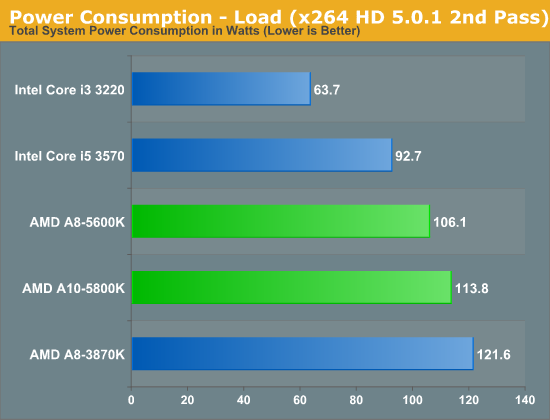AMD A10-5800K & A8-5600K Review: Trinity on the Desktop, Part 2
by Anand Lal Shimpi on October 2, 2012 1:45 AM ESTPower Consumption
Intel has a full process node advantage when you compare Ivy Bridge and Trinity, as a result of that plus an architectural efficiency advantage you just get much better power consumption from the Core i3 than you do with Trinity. Idle power is very good but under heavy CPU load Trinity consumes considerably more power. You're basically looking at quad-core Ivy Bridge levels of power usage under load but performance closer to that of a dual-core Ivy Bridge. AMD really needs a lot of design level efficiency improvements to get power consumption under control. Compared to Llano, Trinity is a bit more efficient it seems so there's an actual improvement there.


Of course on the processor graphics side the story is much closer with Trinity being a bit more power hungry than Ivy Bridge, but not nearly by this margin.










178 Comments
View All Comments
creed3020 - Tuesday, October 2, 2012 - link
I would really appreciate it if a similar test of Trinity as what was done to Llano regarding GPU Performance vs. Memory Speed was completed (http://www.anandtech.com/show/4476/amd-a83850-revi... I am curious if the trend has remained the same, improved, or decreased.I am in the process of building a new Office PC for family whose needs are basic and Trinity fits the bill quite well, especially the A8-5500 or A6-5400K. I want to purchase memory that compliments the GPU well.
On another GPU note I find it strange that there was no test of AMD Radeon Dual Graphics (http://www.amd.com/us/products/technologies/dual-g... as that a native scaling of GPU platform for this APU, not a high end discrete GPU. The latter usage scenario just doesn't seem that common considering the target market for the APU.
Hubb1e - Tuesday, October 2, 2012 - link
Go with 1866 or 1600. 1866 is about 5% faster GPU performance if that matter much in your use case.creed3020 - Wednesday, October 3, 2012 - link
My current HTPC uses an A8-3850 with 1866 memory so I am aware of the benefits, my question is more about getting an understanding of this phenomenon with Trinity. I am curious if it was has become less important or perhaps even more so.I'm not gaming on my APU so there is no concern to squeeze every drop of FPS out of the GPU. I am more curious from a research and review standpoint.
Moizy - Tuesday, October 2, 2012 - link
Anand, you mentioned several times that Trinity holds the integrated graphics and overclockadvantage, while Intel holds the single-threaded and power consumption advantage. To me, though, the A10-5700 attempts to address the power consumption advantage by offering a lower tdp without cutting down the clocks too much (while sacrificing overclockability though).
Throwing in the A10-5700 at some point in the future, assuming you can get your hands on one, would provide an interesting comparison for those interested in Trinity's gpu and competitive power consumption.
ewilliams28 - Tuesday, October 2, 2012 - link
apologies if it's been covered but i would like to know exactly which cards work in this mode. I have heard that if you go too high they don't work together. it's my understanding that 7670 are OEM only and i can't believe that the 6670 that i can buy is still the best i can do. i plan to use 1080p since 1920x1200 has basically gone the way of the dodo bird. but i do like to crank up the settings. luckily the most complicated game i play is World of Warcraft. i will probably fold with this box though.creed3020 - Tuesday, October 2, 2012 - link
http://www.amd.com/us/products/technologies/dual-g...halbhh2 - Tuesday, October 2, 2012 - link
Overall, a Trinity laptop would do fine during idle, which *is about 85%* of what 90% of laptops do when they are on.That matters.
So, an interesting test for real-world use for *most* consumers (wife, kids, most of the people most of us know) would be a run-time battery life test for leaving the computer on, and surfing to 25 web pages, and playing a couple of modest games for 45 minutes, and then watching a streamed movie.
That would be real world use for 90% of laptops.
In view of that, for people that aren't using their laptop in a demanding way, a good question is how much does it cost, and how long does it run until you need to plug in. That's all.
jfelano - Tuesday, October 2, 2012 - link
Why does Anandtech still use 1280x1024 and 1680x1050 as their bencmarks? Is this still 2008?Beenthere - Tuesday, October 2, 2012 - link
Answer: Because most people still use these screen resolutions. This review is for a desktop APU, thus the appropriate screen resolutions.silverblue - Tuesday, October 2, 2012 - link
Hehe... you try playing anything remotely recent at a higher resolution on an IGP...